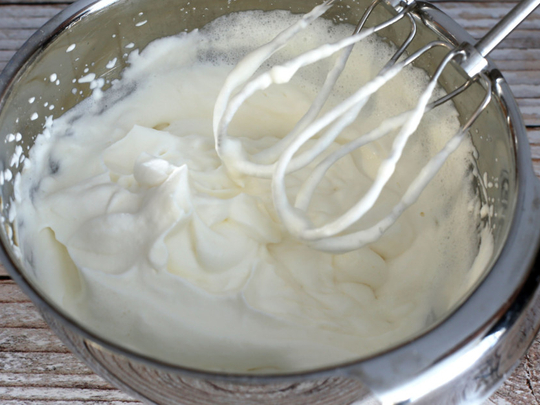
Horses, we know, are whipped. Or, at least, there’s the pretence of it, with the jockey, risen and curved like a bobbing crescent gripping the reins tightly with one hand and flailing away with the whip with the other, cracking the air; and any thought the horse may have had of doing things at a canter disappears at a gallop, so to speak.
Sleek, sweaty manes flying, mouths foaming, bodies stretched with indescribable, muscle-rippling elegance ... A day at the races, track side, will always include the rolling thunder of hooves, crackling excitement in the air and that inevitable crack of the whip.
For those not track side but kitchen-bound, committed to a lifetime of baking and entertaining, we also know of something else other than the horse that is whipped: Cream. Whether it’s done in a modern stand top mixer, or one that is hand held, cream lends itself to the unrelenting delights of whipping and, under the whip, as it were, metamorphoses from milky liquidness to a thick creamy non-flow consistency.
“We know that cream has the inherent nature to change,” as the head chef pointed out to his batch of apprentices, “but it’s the whip that’s required to bring about such an alteration. It cannot happen without the whip.”
This practice of ‘whipping things into shape’ we suspect — and we’d be right, of course — exists in the human sphere as well. It is to be found in the term ‘whipping boy’, nowadays used quite loosely to mean somebody who gets to take the blame for somebody else’s actions.
In its inception, however, a ‘whipping boy’ was a literal person. Somebody who genuinely took the blame for somebody else. In fact, he was hired or employed to do so.
It is thought that this practice originated with the nobility, the royals of the Modern English Period, and began, around 1553, with Edward VI who became king at the tender age of 10. The term, however, is more commonly associated with Charles in particular. (Not my father, who was a Charles, too, but was such a pacifist he wouldn’t have recognised a whip if he saw one, but with Charles the First, King of England in the 1600s.)
Most young princes and would-be kings were home schooled back in the day, history tells us. Tutors were hired to visit the royal palaces and impart knowledge; educate, but with limitations. That is, the tutor couldn’t wield the cane if the prince/future-king didn’t wish to swot up on his logarithms or Pythagoras’s Theorem about the square on the hypotenuse etc. After all, who would dare raise a hand to a future monarch? Instead, he, the tutor, was ‘kindly’ permitted to take his irritation out on a substitute. A whipping boy, in other words. Royal courts of the day, it is said, treated the ‘whipping boy’ as an employable position.
A gentleman known as William Murray, in his youth, was King Charles I’s whipping boy. A disagreeable concept, a despicable, cowardly way of doing things, one is inclined to think. The rationale back then, however, was that this helped form an emotional bond between subject and object ... that is, the King and his subject. That, if the prince were to witness his friend being beaten on his behalf, he would jolly soon pull up his socks and knuckle down to his studies.
It is believed that many princes and their whipping boys became lifelong friends and many of these ‘objects of punishment’ were rewarded handsomely in later life. King Charles went on to appoint William Murray an Earl (of Dysart) and bestow on him palatial residences. The term ‘a pained friend’ became a synonym for a whipping boy and my prankster mate, Barney, reckons he’s become my whipping boy, given all the columns I’ve written about him, telling readers about his prankishness. One day, he tells me, he knows he’ll be rewarded. One day, I remind him, I will never be king. Just so he knows.
Kevin Martin is a journalist based in Sydney, Australia.








